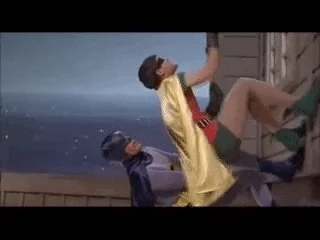Originally published at: Special effect techniques from the past | Boing Boing
…
I love this type of stuff as well. The best part is realizing that many of these same tricks are used in movies today.
Oh my god HOW
ETA: I think I know, but DAMN.
ETAA: (Looking at the caption) Yep, that’s what I thought.
Boasts of having the strength to strangle… then whips out a gun?! ![]()
Great effect with the face, BTW! If that was use of something like matting, but in post… then my hat’s off!!!
The only thing I can figure is a full-sized practical set, and flying Pryce around on wires. Amazing.
Perhaps the first evidence of a return to practical effects in big-film sci-fi was Moon (with Sam Rockwell). The lunar vehicle racing along! Reminded me of Space 1999… but more realistic.
More realistic than Space 1999?!!!
Noooooo!
Sorry to have upset your lunar applecart. ![]()
I haven’t watched Brazil in a long time, but I remember somehow figuring out at one point that it was a miniature (in spite of e.g. the legs moving); we only really see Pryce when it cuts to a close-up. I was thinking it was when he flew in a loop, but this looked better than I remembered.
The flapping of the arms is SO well done, it really sells as full-scale, but no doubt you’re right.
Well, I just watched that clip on a smaller screen – when I noticed, it would’ve been on a larger TV.
P.S. As for the original topic, here I thought I had seen Karel Zeman’s Alice in Wonderland… but, now that I check* it was Jan Švankmajer’s Alice.
*(pun not intended, but there it is)
After enlargement and going frame by frame, I think I know something of how they did the face effect. Before the transformation, her face was very glossy – as if some gel had been applied to her face… then her close-up scene’s overall lighting shifted and, with that, her face. There may have been some substance underneath (?) the “gel” that only revealed itself based on how it was lit (a colored light?). Also, note that in the post-transformation scenes showing her and the other actors, her face was as before the transformation.
Sometimes for composite shots they’d move the camera instead of the subject. For example, if you want to make it look like a guy is falling to his death you can have him lying on his back flailing his limbs on a green screen floor and then quickly yank the camera upwards a few dozen yards so from the camera’s point of view it looks like the actor is falling away.
So for something like this, perhaps they put Pryce on a suspended rig that let the wings flap up and down and then panned the camera around him, then composited the cloud scenery in to make it look like he was moving against the background. It would be interesting to see the making-of though.
Nice to see the sideways camera trick done fairly believably, unlike some examples.

The Criterion Edition of Brazil (one of my all-time favorite movies, along with Time Bandits) has behind the scenes of how the flying scenes were done. Large set with fake clouds and smoke, motorized miniature of Sam with flapping wings, filmed at a super-high frame rate. In real time it flew for a couple seconds. They all thought it was going to turn out terribly until they got the shots back from the lab.
Gilliam is an insane genius. Too bad he’s a complete asshole, too.
I’m 99% certain you’re right. They used the same technique for an early Dr. Jekyll and Mr. Hyde transformation effect. As I recall, they used red paint to paint shadows on the actor’s face. At the start of the shot they used a red light, which caused the red paint to not show up. Then they gradually shifted to blue light, which caused the shadows on the face to gradually appear. It is definitely an effective technique, but wouldn’t really work with color photography.
If I didn’t now know how it was done, I’d be with you except for the compositing - this shot is nearly flawless, and late-'80s compositing was still pretty rough. I like the moving camera idea, though.
Yeah, if you click through to the Youtube site, there’s an explanation. That’s exactly how they did it.

